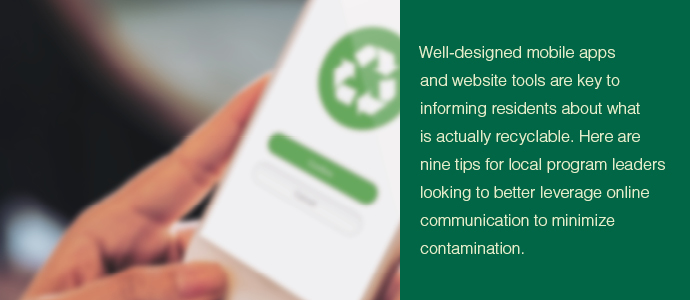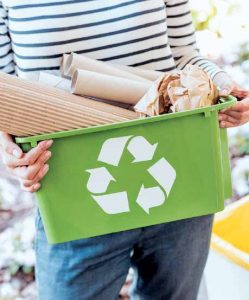
This article appeared in the March 2020 issue of Resource Recycling. Subscribe today for access to all print content.
The effects of excess contamination in the recycling stream have rippled out to touch virtually link in the value chain. But, ultimately, the issue has landed squarely at the feet of recycling educators.
For solid waste managers, recycling coordinators and other local officials, teaching residents to recycle better is the name of the game in 2020.
Empowering residents to recycle right will save resources both natural and economic. In fact, the city of Toronto – which has a population of just under 3 million – determined it could lower solid waste costs by $600,000 to $1 million a year for each percentage point that was cut from the city’s contamination rate, according to a report by the Canadian Broadcasting Corporation.
Similar savings certainly could add up quickly for cities across the U.S., where average recycling contamination is reportedly in the neighborhood of 25%.
How did we get here?
The root causes of material-quality problems in the U.S. and around the world remain up for broad discussion. However, we know that rapidly changing recycling markets and the resulting flux in local and national recycling guidelines have played a significant role. Another factor has been a reluctance by some solid waste professionals to grasp new technologies to reach and engage with residents at a time when residents expect information in digital formats.
For education professionals working at the community level, here are nine simple ideas to help residents develop stronger recycling habits.
1. Know what’s recyclable, then communicate it.
Outlining the specifics of what types of materials are accepted in a local program sounds easy, but it’s tripping up a lot of communities. According to 2017 research from The Recycling Partnership, 60% of studied communities promoted an “accepted materials” list that differed from that of the local MRF.
Taking action on this front can be straightforward. First, talk to your MRF partner’s staff directly and ask them what’s recyclable. Next, identify every place you communicate what is recyclable to the community and make sure it matches the MRF’s list. You could even make a spreadsheet of all the communication vehicles you use, from printed handouts to information cards for frontline staff who answer the phone. Be painstakingly thorough and ensure that messaging is consistent across all communications.
2. Include easy-to-find recycling information on your website.
About half of residents say they turn to internet searches first when they have recycling questions, so make sure your community’s website is clear on the details. This step seems like a no-brainer, but according to The Recycling Partnership’s research, about half of municipalities do not include any recycling information on their sites. Of those that do, about half don’t include specific information about what’s recyclable. Keep info short, concise, skimmable and at the top of your website – no hard-to-find PDFs, please!

3. Meet your resident’s expectations for digital communications.
When it comes to online messaging, residents are accustomed to clean, simple interfaces with intuitive functionality, and they expect nothing less from their local municipal website and accompanying tools that help them learn about recycling. In fact, according to a 2015 McKinsey report titled “Implementing a Citizen-Centric Approach to Delivering Government Services,” residents actually prefer digital interactions with the government. Moreover, educators who own the real-time communication stream that digital provides are better able to build trust between the municipality and the resident, an important key for ongoing communication.
4. Evaluate your print materials – and (probably) let them go.
If you’re still mailing recycling information to residents, it’s time to seriously evaluate the cost of those pieces, including staff time and print and mailing costs. Sadly, in many communities, these resource-intensive materials find their way almost immediately to the recycling bin. But perhaps the most prohibitive characteristic of print is its static nature: It’s incredibly difficult to maintain accuracy, especially when what’s acceptable in your program changes. It bears noting that when the city of Austin, Texas recently canceled its print recycling calendars in favor of digital communications, it saved $66,000 the first year.
5. Move recycling education further into the digital arena.
Most municipalities have at least begun the transition to digital, meaning they’re relatively web savvy and understand the options available in terms of digital applications for communicating with residents. Sometimes, however, educators fear that their community’s demographics just won’t support a total switch to technological tools – and don’t want to leave older constituents out of the loop. But recent data allows us to lay these fears to rest: Even as digital-native millennials are overtaking baby boomers as the largest generation, the boomers themselves are taking up digital tools like Facebook more quickly and in larger numbers than other segments of the population, which blows a hole in the stereotype that residents over the age of 50 don’t appreciate digital interaction.
6. Nix long materials lists and follow the “one, five, 50” rule.
Current behavior science suggests that residents can remember one idea in a mass medium and five things from a face-to-face meeting. For 50 or more ideas, we need to provide information in a searchable database. In other words, long lists of what’s recyclable presented on your website don’t work when it comes to fighting contamination. What-goes-where information needs to be presented in a real-time searchable database via digital website tools or an intuitive mobile app.
 7. Make the most of human interactions – and save money while you’re at it.
7. Make the most of human interactions – and save money while you’re at it.
When residents rely on helpful digital tools to answer their questions about what’s recyclable on the fly, we can avoid costly phone calls (which ring in about $7 each, according to some studies). This move away from the phone also saves staff time. Instead of having to cover the basics, precious face-to-face time can be used to have deeper conversations about environmental topics or even engage residents with a wider breadth of municipal programs and tools. Contamination down, broader environmental engagement up!
8. Build your recycling brand.
If you want residents to recycle better, a little brand psychology goes a long way. In the consumer space, people trust and listen to brands they know. In addition, they take actions sooner and faster with those they trust. Your recycling program, in some sense, is a brand, and the purpose of your brand is to leverage its influence on the web, social media and elsewhere to help residents recycle. Providing correct, consistent information in an expected, easy-to-navigate format goes a long way toward establishing your municipal program as a trusted source for information and a catalyst for positive environmental action.
9. Think like a resident.
The first rule of effective communication is to understand your audience, but often the daily pressures of the solid waste profession can lead us to question our residents’ best efforts. We need not doubt their intent! Research from the U.S. Environmental Protection Agency shows that most people want to recycle – they believe it’s responsible and good for the planet.
The trouble begins when the resident is standing in front of the trash and recycling with an item in hand, wondering what to do. Digital strategy puts the recycling educator in the resident’s shoes and provides a point of connection in that moment of choice, usually via smartphone. Today’s recycling educators are working harder and smarter than ever before to clean up the recycling stream and teach residents how to recycle more and better. With the right strategy and tools for digital communication around solid waste, the scrappy educator has a fighting chance to stem the tide and make a lasting difference.
Todd Mumford is marketing manager at ReCollect Systems, a company that builds digital waste and recycling tools for municipalities and service providers that help reduce contamination, “wishcycling” and call volumes while empowering people to be great recyclers.
The company’s flagship product, the Waste Wizard, helps teach people what goes where, allowing them to easily search for real-time instructions based on a jurisdiction’s accepted-materials list using a mobile app or website tool. Mumford can be contacted at [email protected].

